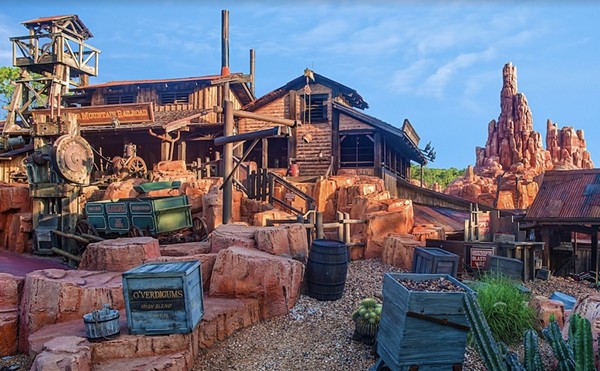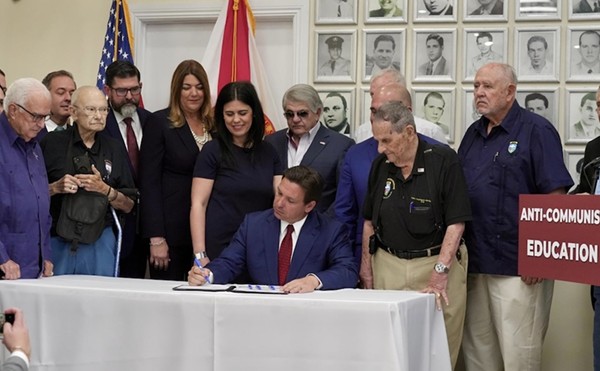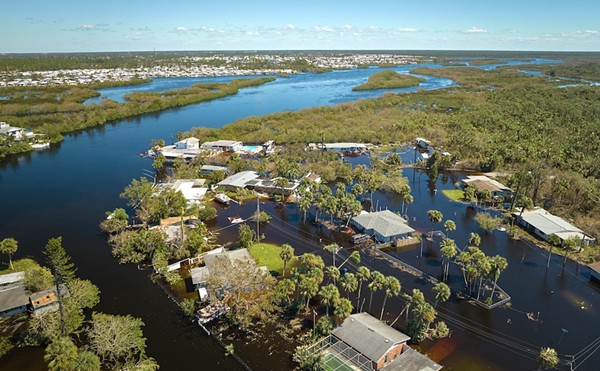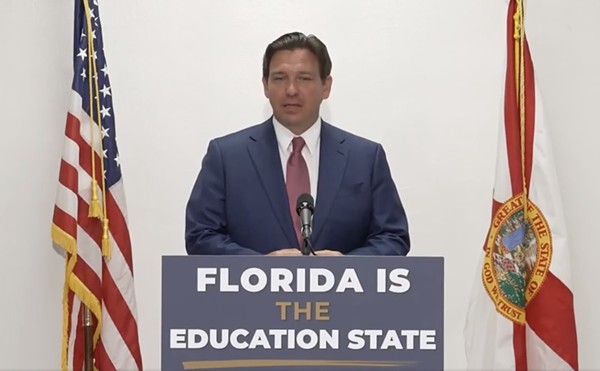In 1992, Amy Perkins paid $400 a month to rent a house downtown on Ferncreek Avenue. That house now rents for $910, and needless to say, Perkins stopped being able to afford the place years ago.
Rents in the $600-$800 range are pushing younger professionals out of the downtown market. The median income for Orlando, according to U.S. Department of Housing and Urban Development, is $29,000 a year, but that might not be enough to cover the costs of living in the area that got its identity from -- and still attracts -- the young, hip, involved and financially up-and-coming.
"This is not where young people can come anymore," says Perkins, who works at the downtown branch of the Orange County Library.
Renters looking for a cheap apartment within two miles of Lake Eola likely won't find one these days. Twenties-era fixer-uppers, the standard in neighborhoods like Lake Eola Heights, Thornton Park, Colonialtown South and Delaney Park, are being renovated by their owners as quickly as the sale contracts are signed. Downtown properties are among the city's most trendy, and the redevelopment boom has caused rental rates to skyrocket.
The average price of a downtown one-bedroom apartment is $708 a month. The lowest rate available for a one-bedroom managed by Olde Town Brokers was $525 a month, with prices reaching as high as $995.
And with development companies moving in, prices may go even higher. When Post Properties completes its redevelopment of The Plaza, the apartment building that looks out over Lake Eola and houses Lee's Lakeside restaurant, rental rates will start at $795 for an efficiency. Nearby, Echelon International Inc. and Zom Communities are building brand-new apartment complexes, with rents starting at $675 a month.
Perkins and her roommate, Laura Cunningham, used to live in separate apartments at The Plaza until Post Properties took over. "We paid about $585 to $595 for studio apartments," says Cunningham. But both were unhappy with the way Post dealt with the existing residents. Tenants received "just a legal notice that Post was taking over the place," says Cunningham.
"At first they told us they wouldn't raise the rate," says Perkins. "Then they told us `the rent would be` about $720. But that was just a quote. Then they wanted us to pay month-to-month." Both eventually asked to be let out of their leases.
Perkins and Cunningham now share a two-bedroom renovated house in Colonialtown, paying a total of about $900 a month. It's affordable, but they see an area that is quickly becoming cost-prohibitive -- thereby losing its mixed-income variety.
"The great thing about `downtown` was that you could get a nice place, a little run-down, but very cheap," says Cunningham. But both women say that rental and sale prices have gone up noticeably. Cunningham estimates that rental rates downtown increased 30 percent in the past year.
They couldn't afford to rent from Post Properties, and they couldn't find a reasonably priced house near Lake Eola. "We've gone up to half our salaries to make our rent," says Cunningham.
If renters are feeling the pinch, their landlords are facing difficulties of their own. Federal tax law changes, historic-preservation initiatives and neighborhood pressure to revamp properties has reduced profits.
"It almost costs money to have rental properties anymore," says Gerard Cherney, who owns eight properties around Orange County, including one downtown. He cites the closing of tax loopholes this year as one profit-buster. "You can't write off rental property income," he says, explaining that second mortgages no longer offer tax breaks.
Cherney says he tries to keep rent hikes to a minimum, raising rates about $25 a year on the two-bedroom, $950-a-month Amelia Street house he rents. "There are times that I will put in a $25 escalator in a six-month period," he admits, depending on how much he spends to keep up the property. Maintenance and remodeling costs on the house take a chunk out of profits.
Despite those costs, the popularity of downtown housing has kept Cherney's property from sitting empty between renters. He gets about 300 calls every time he puts up the "For Rent" sign.
Other downtown property owners say they face the same problems. Terry Reilly, who manages a remodeled home on Pine Street for an out-of-town owner, says he keeps his rental rates at 5 to 10 percent under the market rate. He has raised prices on the apartments only 10 percent in the past three years.
In fact, he has frozen the rent on the Pine Street property for now because of the construction noise made by the nearby Parkside by Post renovations.
He keeps prices down, he says, by carefully choosing his tenants, doing extensive credit checks and refusing pets. He also makes sure the owners take care of their properties. "I don't manage trash properties," he says firmly.
Reilly's tenants agree that prices are still affordable for now (see Prepare yourself for the hunt), but they worry about what will be available in the near future. "This is about as close as you can get to Lake Eola for the price," says Patrick Gill, who rents a downstairs efficiency for $505. However, he says, as a bulldozer rumbles down the street toward the Post property, "I don't expect this place to be around much longer ... I wouldn't be surprised to see this place gone in two years."
His neighbor Marti Matonis moved from the Lake Underhill area to be closer to work. "I like the location," she says, "and I wanted cooler neighbors" -- the precise reasons why some people are willing to pay the higher rents. She's optimistic that others like her will keep this scene from changing anytime soon. "It's fun downtown. Everybody's really young ... a lot of people work downtown."
Gill disagrees. "I've seen a lot of change, `like` the Go Lounge closing, `and now` a lot of places are opening for young professionals that are really high priced."
Twenty years ago, downtown Orlando was an eclectic mix of run-down houses populated by students, artists and retirees. More vagrants wandered the streets, contributing to a higher crime rate, though longtime residents say the problem wasn't as bad as the statistics make it appear.
"I lived down there when, basically, people lived there `because of the` cheap rent," says Valerie Kennedy, of Colonialtown Realty. She grew up downtown and now does what her mother did in the '70s: investing in, renovating and selling area properties. The house she bought on Hyer Street for $28,000 in 1978 sold recently for $100,000.
Terry Reilly started his real-estate career in the early '80s. "All this area was really kind of run down," he says. His tenants then were mostly blue-collar workers, renting weekly. He first noticed a change in the market about five or six years ago, and "maybe as far back as 1990-92. Now prices in Colonialtown are going up."
As a result, he says, "It's probably the best time to be a landlord `in Orlando` that I've seen."
Bob Sanders of Olde Town Brokers agrees, noting that prices have gone up "dramatically." The city has hit its stride. "Orlando is really growing now," he says.
The downtown rush and the large-scale renovations that are happening -- or not happening, in some cases -- has had another effect: the designation of many neighborhoods as historic-preservation districts. While the designation works to protect the buildings from being destroyed or renovated beyond recognition, some tenants are fearful of the requirements that come along with historic districting.
"We definitely don't want the historic district," says Cunningham, whose Colonialtown neighborhood, north of State Road 50, is being considered for the designation. "I'm all for aesthetics, but it means I'm out."
Kennedy, of Colonialtown Realty, disagrees. "I think people have this idea that it's going to make property values go through the roof," she says. But it's the houses themselves, rather than the designation, that draw people. "There's such an awareness and appreciation of historic houses now," says Kennedy. "Pride of ownership is driving prices up, not the historic-preservation initiative."
Colonialtown South, an enclave of about 400 homes south and east of State Road 50 and Mills Avenue, is entering the final stages of the historic-district approval process. The neighborhood association and its historic-district board have carefully considered the issue of improvements to properties.
"Our requirements are very loose," says Bill Sevlie, president of the neighborhood association. "We try to be very lenient because we have a lot of older people who are concerned" -- both about any change in general and about the specific costs of bringing their properties into line with a set standard. If approved, Colonialtown South's historic-district codes will not force homeowners to make improvements to existing property.
Lake Eola Heights, which became a historic-preservation district in the late 1980s, has stricter codes. According to one owner, pressure -- from the city and from neighbors -- to improve his property has increased. "If you're a property owner, you really don't have nothing to say about nothing," says the landlord, who runs two eight-unit apartment buildings on Concord Street. He says he noticed code changes after the historic-preservation district was approved, and that there is stricter enforcement of those building codes by "adversarial" city inspectors.
"Every time they come around and inspect it, they want another change," he says. "You've got state licensing inspectors, then city inspectors. ... Why does the state duplicate what the city does? Now the county wants to come in on it. Everybody's trying to make a profit."
The popularity of living downtown brings with it an ever-increasing price. But who is getting caught between the influx of higher-paid professionals and the outstretched arms of landlords, developers and city planners?
Megan Whyte, a member of the Sak Comedy Lab who rents a two-bedroom apartment on Hyer Street, worries about the effect that higher rental prices will have on the community. "For me, it would be devastating, because I would have to leave the only part of town I want to live in. If you want that sort of artistic influence, and you raise the rents that high, you'll lose that influence," she laments. "It just wouldn't be diversified."
Additionally, few other areas offer the convenience of being within a few blocks of work, shopping and clubs. "The mall is here -- just up `Colonial Drive` -- and so's my doctor, the gas station. I also have the downtown life."
Olde Town's Sanders says that "downtown life" is precisely what attracts out-of-state professionals, with higher incomes, to the area. And they're willing to pay more rent to experience Orlando" s eclectic neighborhoods. "That's basically the future of downtown," he predicts.
Olde Town Brokers targets renters who make $50,000 or more, and Sanders points out that new developments, like Parkside by Post and Echelon at Cheney Place, are "certainly" catering to this income level. Downtown and neighborhoods like College Park have become trendy, he says. "That alone makes them more and more desirable and more and more expensive. The real-estate market is its own beast," Sanders explains. "They always blame us for the high prices, but it's not our fault."
Cunningham fears that younger workers and artists might eventually be pushed out of downtown. "Orlando's young professionals are underpaid," she says, pointing out that some manual-labor-type jobs pay more money than entry-level office work.
Perkins feels that downtown is in danger of duplicating Winter Park's income-split community. "It really is going to draw a district line. Look at Winter Park. There's this big boom on Park Avenue, but two streets over there's almost abject poverty."
Some aspects of the Winter Park attitude are already apparent near downtown, says Cunningham. "We went `to an area complex` and found a bigger place for about $850. But this guy was such a snob. He walked past me and said, 'Is that your car?' and pointed to a BMW" -- which was parked in front of her late-model Ford. He apparently wasn't pleased that the BMW wasn't hers. "He didn't even put through our credit check because he didn't like it.
"Well, he said it was because of our cats," Perkins says. "But when we first talked to him, he was fine with it."
"I'm used to that kind of attitude maybe in Rollins or Winter Park," adds Cunningham, with a laugh, "but this was down on Robinson, and it wasn't that great `an apartment`."
Perkins, who is finishing a degree at Rollins College's Hamilton Holt School, is thinking about leaving Orlando entirely. "I'd rather move to a new city than fight this market."
Other renters aren't considering such drastic measures, but they are keeping an eye on the market. "If it starts to become an industry, prices might skyrocket," says Whyte. However, she hasn't seen prices yet go above what she can afford.
Gill and Matonis, the Pine Street tenants, think rates won't go sky-high. "People are only going to pay what they can afford," says Gill.
Matonis agrees that renters won't pay high prices to live downtown. "Not when you can go 10 minutes down the road and get a house, sometimes with a pool," for $950-$1,000 a month. "Some of my friends live down on Conway, and that's what they're paying."
They may be right. Realtor Kennedy points out that the owner of a two-bedroom rental in Colonialtown South had to drop his asking price when no one responded to the original $1,300 rate.
If tenants are correct about the financial limits of Orlando residents -- and HUD statistics seem to bear this out -- development companies, wooed by multimillion-dollar incentives from the city government, may have a tough time filling their new complexes.
"Who are they targeting here?" asks Cunningham. "I don't think they're going to get the market they're looking for."
Perkins agrees that aiming too high won't work. "If they don't target the young, up-and-coming professionals, they're missing out."
Kennedy sees downtown Orlando's rapid growth and redevelopment as a positive sign, but she is aware of the dangers of expanding so quickly. "We do have to grow responsibly," she says. "The things that we're falling in love with we don't want to have taken away."
"There's a certain amount of people who actually care about downtown," says Matonis. "All my friends are, like, laughing at me `for renting downtown`. But certain people, like my sister, won't live anywhere else."



















